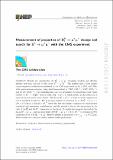Measurement of properties of Bs0$$ {\mathrm{B}}_{\mathrm{s}}^0 $$→ μ+μ− decays and search for B0→ μ+μ− with the CMS experiment
Author(s)
Sirunyan, A. M; Tumasyan, A.; Adam, W.; Ambrogi, F.; Bergauer, T.; Brandstetter, J.; Dragicevic, M.; Erö, J.; Escalante Del Valle, A.; Flechl, M.; Frühwirth, R.; Jeitler, M.; Krammer, N.; Krätschmer, I.; Liko, D.; Madlener, T.; Mikulec, I.; Rad, N.; ... Show more Show less
Download13130_2020_Article_12912.pdf (897.6Kb)
Publisher with Creative Commons License
Publisher with Creative Commons License
Creative Commons Attribution
Terms of use
Metadata
Show full item recordAbstract
Abstract
Results are reported for the Bs0$$ {\mathrm{B}}_{\mathrm{s}}^0 $$→ μ+μ− branching fraction and effective lifetime and from a search for the decay B0→ μ+μ−. The analysis uses a data sample of proton-proton collisions accumulated by the CMS experiment in 2011, 2012, and 2016, with center-of-mass energies (integrated luminosities) of 7 TeV (5 fb−1), 8 TeV (20 fb−1), and 13 TeV (36 fb−1). The branching fractions are determined by measuring event yields relative to B+→ J/ψK+ decays (with J/ψ → μ+μ−), which results in the reduction of many of the systematic uncertainties. The decay Bs0$$ {\mathrm{B}}_{\mathrm{s}}^0 $$→ μ+μ− is observed with a significance of 5.6 standard deviations. The branching fraction is measured to be ℬBs0→μ+μ−=2.9±0.7exp±0.2frag×10−9$$ \mathrm{\mathcal{B}}\left({\mathrm{B}}_{\mathrm{s}}^0\to {\upmu}^{+}{\upmu}^{-}\right)=\left[2.9\pm 0.7\left(\exp \right)\pm 0.2\left(\mathrm{frag}\right)\right]\times {10}^{-9} $$, where the first uncertainty combines the experimental statistical and systematic contributions, and the second is due to the uncertainty in the ratio of the Bs0$$ {\mathrm{B}}_{\mathrm{s}}^0 $$ and the B+ fragmentation functions. No significant excess is observed for the decay B0→ μ+μ−, and an upper limit of ℬ(B0 → μ+μ−) < 3.6 × 10−10 is obtained at 95% confidence level. The Bs0$$ {\mathrm{B}}_{\mathrm{s}}^0 $$→ μ+μ− effective lifetime is measured to be τμ+μ−=1.70−0.44+0.61$$ {\tau}_{\upmu^{+}{\upmu}^{-}}={1.70}_{-0.44}^{+0.61} $$ ps. These results are consistent with standard model predictions.
Date issued
2020-04-28Department
Massachusetts Institute of Technology. Department of PhysicsPublisher
Springer Berlin Heidelberg
Citation
Journal of High Energy Physics. 2020 Apr 28;2020(4):188
Version: Final published version